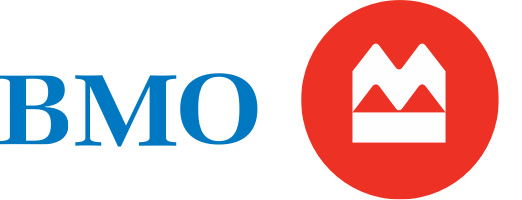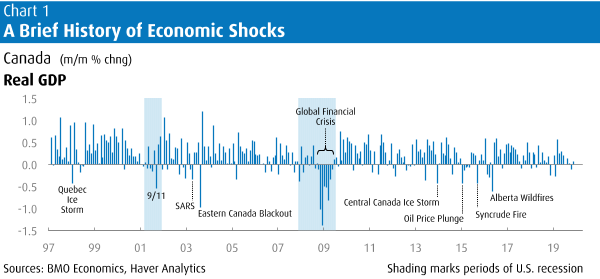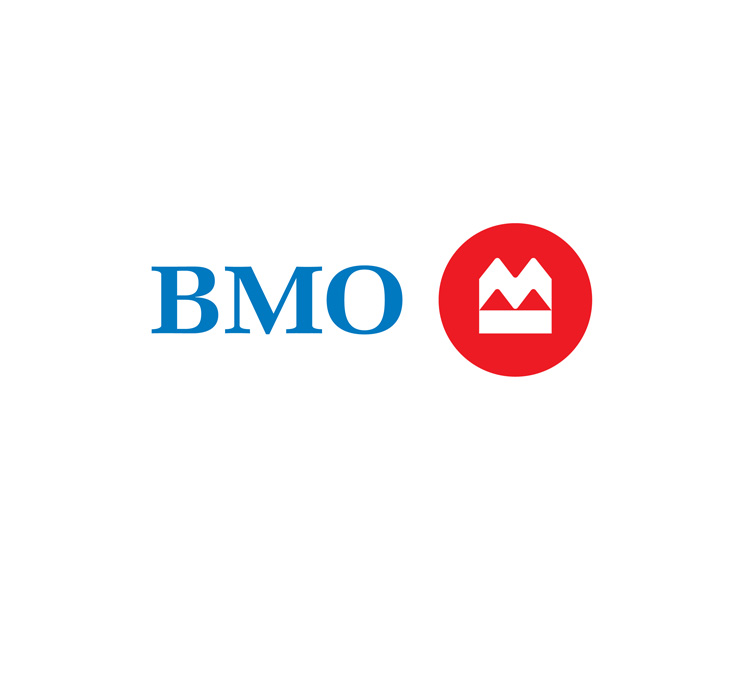
Pandemic Preparedness: What If?
-
bookmark
-
print

- Keywords:
- coronavirus
- covid-19


“The interconnectedness of our economies means that literally, no man is an island. If one economy starts to struggle, the spillover effects onto others can take hold rapidly.”—New York Fed President John Williams, November 2019
Human suffering from the outbreak of COVID-19 is clearly much more important than the economic impact of the virus, one of the reasons why we address this topic so reluctantly. The other reason is that there is still such a wide range of potential outcomes for the North American economy—from quite mild to severe—and each so dependent on initial assumptions that any conclusion is necessarily vague. But the accelerating spread of the novel coronavirus to countries outside China—most notably, Korea, Japan, Iran and Italy, and U.S. health officials warning of its imminent spread stateside—has roiled financial markets, and is likely to cause widespread forecast revisions. Prior to this week, consensus growth estimates for the U.S. and Canada had not budged since the start of the year; that seems poised to change. Specifically for Canada, watch for some significant revisions following Friday's 2019Q4 GDP results, which are expected to reveal nearly no growth at the end of last year—even before the virus was an issue.
There have been many attempts in recent years to model the economic impact of pandemics, with studies reaching back to prior episodes such as the severe 1918 Spanish flu, milder outbreaks in 1957 and 1968, the 2002/03 SARS epidemic, and the 2009 H1N1, or swine flu, pandemic. These models must make assumptions on everything from morbidity and mortality rates, to absenteeism among workers, to supply-chain disruptions, to consumer savings patterns, and, of course, to policy responses. Not surprisingly, with such a wide range for inputs, the conclusions are also quite diverse. We looked at 17 different pandemic scenarios (and removed the two extremes), from eight different authors from a variety of countries. Estimates to the economic growth hit ranged from as low as 0.6 percentage points in Year 1, to as high as 6.8 percentage points. (Some studies covered specific economies, while others looked at the global impact.) The median estimate of the models studied is a 1.6 percentage point hit to growth in the domestic economy covered in the first year, with a near complete rebound the following year.
Our own department studied the issue in great detail in 2005/06, when concerns about the avian flu were emerging (“The Avian Flu Crisis: An Economic Update”, March 2006). At that time, Sherry Cooper estimated that the annual loss of real GDP growth would be roughly 2 percentage points in a mild pandemic scenario, and up to 6 percentage points in a severe case, with the hits to Canada and the U.S. of roughly similar magnitudes. In other words, instead of the roughly 2% growth the consensus had been expecting for U.S. growth this year, we would be looking at something close to zero in a mild pandemic scenario and a drop of 4% in a severe case, by these calculations. These estimates skewed somewhat larger than others due, in part, to “the addition of a supply-side disruption in trade and, therefore, significant supply-chain dislocations”.
While that’s a reasonable assumption, some analysts believe the growth hit would be considerably lighter. That same year, Finance Canada estimated that a mild pandemic would cut Canada’s GDP by 0.4 percentage points in a year, while a severe case would clip 1.1 ppts. Authors James and Sargent asserted that spillover effects from shocks are typically overestimated or exaggerated, arguing that “societies are extraordinarily adaptable” and “for almost every direct negative effect there is a potential offsetting response.” They found that monthly data on retail sales and railway car loadings show that the severe 1918 flu had minimal impact on behaviour and activity at that time, despite widespread media coverage. And, looking back at how people responded in the SARS episode, the authors say:
“In the case of SARS, they avoided travelling to the locus of infection. However, what they did not do is as interesting as what they did do. Those who actually lived in Hong Kong, Singapore, Taiwan and Toronto did not “hunker down” or flee in panic. Rather, they carried on with their lives, including working and shopping. They may have been anxious—50% of Taiwan respondents reported wearing a mask during the height of SARS—but they did not become paralyzed with fear, even in the face of intense media coverage.”
In addition, it’s reasonable to assume that the recovery from any growth hit would be V-shaped. Past pandemics have not lasted much beyond a quarter, and typically the economic recovery is swift. For example, while China is no doubt digging a deep hole for growth in Q1, we continue to believe that activity will fully rebound by Q3 (with supply-chain issues delaying the recovery by a quarter). For evidence closer to home, looking at the history of monthly Canadian GDP since the late 1990s clearly displays that even serious shocks tend to be one-month affairs that are typically retraced the very next month (Chart 1). The only sustained drop in output was during the 2008/09 financial crisis, and the current series of events has little in common with that episode.

Finally, there is a very real prospect that policymakers will respond to any serious economic damage- or potentially even the risk thereof-in a meaningful way. While we doubt that monetary policy is a particularly useful tool to combat what is primarily a supply shock, it could mitigate any related weakness in demand—prompted by fear of going out (FOGO) and/or concern about loss of income from an economic slowdown. In that vein, markets are now fully priced for 50 bps of rate cuts this year by both the Fed and the Bank of Canada. Similarly, fiscal policy could play a temporary role in offsetting a drop in demand; some public spending ramp-up may flow in any event from higher health care spending and containment efforts. We were already expecting this year’s Federal Budget to lean into stimulus, with spending and the deficit ramping up, and deepening coronavirus concerns simply reinforce that view.
Bottom Line: The risks to the global economy from COVID-19 have clearly increased with its sudden and rapid spread in major economies outside of China. It is by no means a foregone conclusion that the virus will spread widely in North America. But even in that unfortunate scenario, the economic damage would likely be equivalent to a short, sharp, shock to growth, and activity would likely recover quickly.
View important Disclosure Statements here .
.

Douglas Porter
Chief Economist and Managing Director
416-359-4887
Douglas Porter has over 30 years of experience analyzing global economies and financial markets. As Chief Economist at BMO Financial Group and author of the popular…(..)
View Full Profile >“The interconnectedness of our economies means that literally, no man is an island. If one economy starts to struggle, the spillover effects onto others can take hold rapidly.”—New York Fed President John Williams, November 2019
Human suffering from the outbreak of COVID-19 is clearly much more important than the economic impact of the virus, one of the reasons why we address this topic so reluctantly. The other reason is that there is still such a wide range of potential outcomes for the North American economy—from quite mild to severe—and each so dependent on initial assumptions that any conclusion is necessarily vague. But the accelerating spread of the novel coronavirus to countries outside China—most notably, Korea, Japan, Iran and Italy, and U.S. health officials warning of its imminent spread stateside—has roiled financial markets, and is likely to cause widespread forecast revisions. Prior to this week, consensus growth estimates for the U.S. and Canada had not budged since the start of the year; that seems poised to change. Specifically for Canada, watch for some significant revisions following Friday's 2019Q4 GDP results, which are expected to reveal nearly no growth at the end of last year—even before the virus was an issue.
There have been many attempts in recent years to model the economic impact of pandemics, with studies reaching back to prior episodes such as the severe 1918 Spanish flu, milder outbreaks in 1957 and 1968, the 2002/03 SARS epidemic, and the 2009 H1N1, or swine flu, pandemic. These models must make assumptions on everything from morbidity and mortality rates, to absenteeism among workers, to supply-chain disruptions, to consumer savings patterns, and, of course, to policy responses. Not surprisingly, with such a wide range for inputs, the conclusions are also quite diverse. We looked at 17 different pandemic scenarios (and removed the two extremes), from eight different authors from a variety of countries. Estimates to the economic growth hit ranged from as low as 0.6 percentage points in Year 1, to as high as 6.8 percentage points. (Some studies covered specific economies, while others looked at the global impact.) The median estimate of the models studied is a 1.6 percentage point hit to growth in the domestic economy covered in the first year, with a near complete rebound the following year.
Our own department studied the issue in great detail in 2005/06, when concerns about the avian flu were emerging (“The Avian Flu Crisis: An Economic Update”, March 2006). At that time, Sherry Cooper estimated that the annual loss of real GDP growth would be roughly 2 percentage points in a mild pandemic scenario, and up to 6 percentage points in a severe case, with the hits to Canada and the U.S. of roughly similar magnitudes. In other words, instead of the roughly 2% growth the consensus had been expecting for U.S. growth this year, we would be looking at something close to zero in a mild pandemic scenario and a drop of 4% in a severe case, by these calculations. These estimates skewed somewhat larger than others due, in part, to “the addition of a supply-side disruption in trade and, therefore, significant supply-chain dislocations”.
While that’s a reasonable assumption, some analysts believe the growth hit would be considerably lighter. That same year, Finance Canada estimated that a mild pandemic would cut Canada’s GDP by 0.4 percentage points in a year, while a severe case would clip 1.1 ppts. Authors James and Sargent asserted that spillover effects from shocks are typically overestimated or exaggerated, arguing that “societies are extraordinarily adaptable” and “for almost every direct negative effect there is a potential offsetting response.” They found that monthly data on retail sales and railway car loadings show that the severe 1918 flu had minimal impact on behaviour and activity at that time, despite widespread media coverage. And, looking back at how people responded in the SARS episode, the authors say:
“In the case of SARS, they avoided travelling to the locus of infection. However, what they did not do is as interesting as what they did do. Those who actually lived in Hong Kong, Singapore, Taiwan and Toronto did not “hunker down” or flee in panic. Rather, they carried on with their lives, including working and shopping. They may have been anxious—50% of Taiwan respondents reported wearing a mask during the height of SARS—but they did not become paralyzed with fear, even in the face of intense media coverage.”
In addition, it’s reasonable to assume that the recovery from any growth hit would be V-shaped. Past pandemics have not lasted much beyond a quarter, and typically the economic recovery is swift. For example, while China is no doubt digging a deep hole for growth in Q1, we continue to believe that activity will fully rebound by Q3 (with supply-chain issues delaying the recovery by a quarter). For evidence closer to home, looking at the history of monthly Canadian GDP since the late 1990s clearly displays that even serious shocks tend to be one-month affairs that are typically retraced the very next month (Chart 1). The only sustained drop in output was during the 2008/09 financial crisis, and the current series of events has little in common with that episode.

Finally, there is a very real prospect that policymakers will respond to any serious economic damage- or potentially even the risk thereof-in a meaningful way. While we doubt that monetary policy is a particularly useful tool to combat what is primarily a supply shock, it could mitigate any related weakness in demand—prompted by fear of going out (FOGO) and/or concern about loss of income from an economic slowdown. In that vein, markets are now fully priced for 50 bps of rate cuts this year by both the Fed and the Bank of Canada. Similarly, fiscal policy could play a temporary role in offsetting a drop in demand; some public spending ramp-up may flow in any event from higher health care spending and containment efforts. We were already expecting this year’s Federal Budget to lean into stimulus, with spending and the deficit ramping up, and deepening coronavirus concerns simply reinforce that view.
Bottom Line: The risks to the global economy from COVID-19 have clearly increased with its sudden and rapid spread in major economies outside of China. It is by no means a foregone conclusion that the virus will spread widely in North America. But even in that unfortunate scenario, the economic damage would likely be equivalent to a short, sharp, shock to growth, and activity would likely recover quickly.
View important Disclosure Statements here .
.
More Insights
Tell us three simple things to
customize your experience.






Contact Us
Banking products are subject to approval and are provided in the United States by BMO Bank N.A. Member FDIC. BMO Commercial Bank is a trade name used in the United States by BMO Bank N.A. Member FDIC. BMO Sponsor Finance is a trade name used by BMO Financial Corp. and its affiliates.
Please note important disclosures for content produced by BMO Capital Markets. BMO Capital Markets Regulatory | BMOCMC Fixed Income Commentary Disclosure | BMOCMC FICC Macro Strategy Commentary Disclosure | Research Disclosure Statements.
BMO Capital Markets is a trade name used by BMO Financial Group for the wholesale banking businesses of Bank of Montreal, BMO Bank N.A. (member FDIC), Bank of Montreal Europe p.l.c., and Bank of Montreal (China) Co. Ltd, the institutional broker dealer business of BMO Capital Markets Corp. (Member FINRA and SIPC) and the agency broker dealer business of Clearpool Execution Services, LLC (Member FINRA and SIPC) in the U.S. , and the institutional broker dealer businesses of BMO Nesbitt Burns Inc. (Member Canadian Investment Regulatory Organization and Member Canadian Investor Protection Fund) in Canada and Asia, Bank of Montreal Europe p.l.c. (authorised and regulated by the Central Bank of Ireland) in Europe and BMO Capital Markets Limited (authorised and regulated by the Financial Conduct Authority) in the UK and Australia and carbon credit origination, sustainability advisory services and environmental solutions provided by Bank of Montreal, BMO Radicle Inc., and Carbon Farmers Australia Pty Ltd. (ACN 136 799 221 AFSL 430135) in Australia. "Nesbitt Burns" is a registered trademark of BMO Nesbitt Burns Inc, used under license. "BMO Capital Markets" is a trademark of Bank of Montreal, used under license. "BMO (M-Bar roundel symbol)" is a registered trademark of Bank of Montreal, used under license.
® Registered trademark of Bank of Montreal in the United States, Canada and elsewhere.
™ Trademark of Bank of Montreal in the United States and Canada.
The material contained in articles posted on this website is intended as a general market commentary. The opinions, estimates and projections, if any, contained in these articles are those of the authors and may differ from those of other BMO Commercial Bank employees and affiliates. BMO Commercial Bank endeavors to ensure that the contents have been compiled or derived from sources that it believes to be reliable and which it believes contain information and opinions which are accurate and complete. However, the authors and BMO Commercial Bank take no responsibility for any errors or omissions and do not guarantee their accuracy or completeness. These articles are for informational purposes only.
This information is not intended to be tax or legal advice. This information cannot be used by any taxpayer for the purpose of avoiding tax penalties that may be imposed on the taxpayer. This information is being used to support the promotion or marketing of the planning strategies discussed herein. BMO Bank N.A. and its affiliates do not provide legal or tax advice to clients. You should review your particular circumstances with your independent legal and tax advisors.
Third party web sites may have privacy and security policies different from BMO. Links to other web sites do not imply the endorsement or approval of such web sites. Please review the privacy and security policies of web sites reached through links from BMO web sites.
Notice to Customers
To help the government fight the funding of terrorism and money laundering activities, federal law (USA Patriot Act (Title III of Pub. L. 107 56 (signed into law October 26, 2001)) requires all financial organizations to obtain, verify and record information that identifies each person who opens an account. When you open an account, we will ask for your name, address, date of birth and other information that will allow us to identify you. We may also ask you to provide a copy of your driver's license or other identifying documents. For each business or entity that opens an account, we will ask for your name, address and other information that will allow us to identify the entity. We may also ask you to provide a copy of your certificate of incorporation (or similar document) or other identifying documents. The information you provide in this form may be used to perform a credit check and verify your identity by using internal sources and third-party vendors. If the requested information is not provided within 30 calendar days, the account will be subject to closure.

